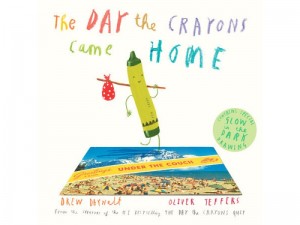I honestly held off as long as possible. As soon as I found out that Drew Daywalt made another Crayon book I knew I had to have it!
Why I Finished It:
I didn’t just finish it, I read it a few times and studied the drawings by Oliver Jeffers. I had extremely high expectations for this book, considering how much I enjoyed The Day The Crayons Quit, and it delivered. Just like in the first book, the crayons “pen” letters to Duncan explaining their unique situations. This time, they are writing postcards and expressing their dissatisfaction with being lost or left somewhere and requesting a rescue of sorts. Just like in the first one, the voice of each crayon is entertaining and will speak to the kids reading.
Who I Would Give It To:
First and foremost, I will be sharing this book with my college students. Since most kids have had the first book read to them last year, I know they will love this one too!
Integration Ideas:
Letter Writing and Voice:
Discuss with students the purpose of postcards. Ask questions like: Why would someone write a postcard? What do you think the reader would like to know? This discussion should lead the students to the idea that postcards are written when people travel, so readers will want to know about their location. Different ideas for students writing postcards:
- After reading a story, students can write a postcard from the point of view of one of the characters.
- Students can research a place as part of a research unit, then write a postcard as if they visited there.
- Students can design and write a postcard from a place they visited (this can even be a grocery store)!
Drew Daywalt is a master of voice! The personality of each crayon comes through in each postcard. After the story has been enjoyed for the sake of enjoying a fabulous story, use this book as a mentor text. Truthfully, you can choose any page, or a different page each day, but I have chosen the first postcard by Neon Red Crayon. Read this page to the students and ask them to describe Neon Red’s personality. Ask students to describe this crayon as much as possible. Then ask why. What words made you think Neon Red was all those things? Perhaps the sentence, “Clearly you do NOT, BECAUSE I’M STILL HERE!” might attract students attention. Ask the students what this sentence made them think about Neon Read. Perhaps they feel he is demanding, confident, etc. Discussion is vital in this lesson. Let students compare the crayon’s personality to people they know or other characters they have read about. Have student take this information into their own writing. Have them pick one of their drafts and share with a classmate the personality of the main character. Then decide how they can express that in words and edit their writing.
Character Traits:
This is a great time to discuss the character traits of each crayon. After the story has been enjoyed, read one page a day as a mentor. After reading, discuss why Daywalt chose to sign the crayon the way he did. As a class, create a list of character traits for the crayon. Post the students ideas somewhere in the class.
Technology:
While people might not physically send postcards much anymore, there are lots of ways to design one online. Students can take or draw a picture of their location, after researching as mentioned above, and incorporate their image into one of the following tools:
Canva: https://www.canva.com/ Canva has a postcard template (click on More and scroll down to Events).
ReadWriteThink: http://www.readwritethink.org/classroom-resources/student-interactives/postcard-creator-30061.html
PhotoCard App: https://itunes.apple.com/us/app/photocard-by-bill-atkinson/id333208430?mt=8
Social Studies Integration:
If you want to get really involved, you can even extend the study of postcards into social studies! As students research places and create postcards from those places, you can create a class Google Map! Students can download their postcards as images and then upload them to the placemarker on the Google Map to visually represent from where their postcard was “mailed.” You could include a conversation about the human characteristics of place and talk about the transportation in that part of the world, languages, culture, or whatever else required by the standards for your grade level. You might even have students talk about some of those things as they write their postcard.
Extras:
Author Video: https://www.youtube.com/watch?v=fAWolzzeYQ4
Website: http://www.crayonspicturebooks.com/
Have you already purchased this book? Have you read it to your students?







Thank you for sharing info on this book. It looks like a great story.
I love The Day The Crayons Quit, so I’ve been very interested in reading this one! Thank you for the review, now I HAVE to get it 🙂 really enjoy the character traits and technology application. Thanks so much for the info!
Can’t wait to read this book!!
Love this book! My students live to hear it read. Thanks for sharing different ways to use the book.
I really like the idea of making a postcard using canva! I’m excited to try it!
Love this book! I read it to my students last year just as a read aloud and they loved it as well. I am excited to see the tips and ideas you presented and want to try them out in the coming school year.
Please share when you do!
So many great ideas!!! I can’t wait to use this in my classroom!!
Love this book!! I have used it with my students to focus on letter writing!! The students loved pretending they were crayons and telling their stories!!! Thank you for sharing!!
#BLI2016KISD
It is definitely a class favorite everywhere! So glad he wrote a second one!